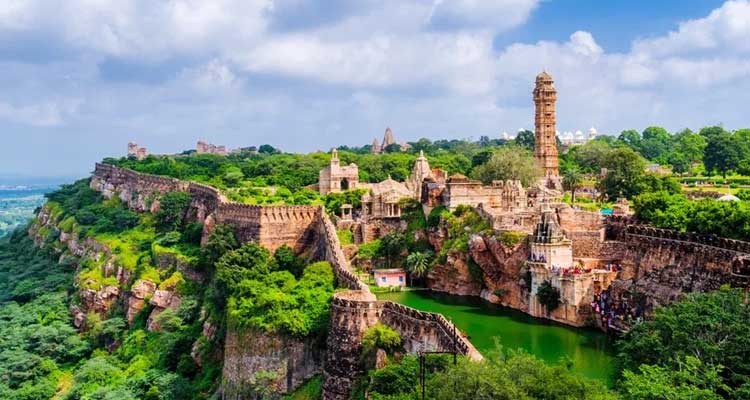Chittorgarh, resonates with stories of Rajputana bravery, pride and passion. The bards of Rajasthan sing tales of courage and sacrifice recounting stories that are known to every child and adult in the city. Chittorgarh is named after its most imposing structure, the Chittorgarh Fort which stands atop a 180 metre high hill and is spread across 700 acres.
Chittorgarh Fort has had a tumultuous past. This bastion of the Rajputs has faced violent attacks thrice in its entire history. The first was in 1303 when the Sultan of Delhi, Ala-ud-din Khilji, who was enamoured by Queen Padmini, launched an attack to abduct her. More than two centuries later, in 1533, it was Bahadur Shah, the Sultan of Gujarat, who caused immense destruction. Four decades later, in 1568, Mughal Emperor Akbar attacked and seized the fort. It was finally in 1616, under the rule of Mughal Emperor Jahangir that the fort was returned to the Rajputs.
Places To Visit In Chittorgarh
Chittorgarh Fort: While it is difficult to arrive at the exact date the fort was established, legend has it that the construction of the Chittorgarh Fort was initiated by Bhim, a Pandava hero from the mythological epic Mahabharata. The fort houses several magnificent monuments, some unfortunately ravaged by time.
Ratan Singh Palace: The winter palace of the royal family, it overlooks a small lake. Although fairly rundown now, it is an interesting place to explore and attracts many tourists.
Gaumukh Reservoir: Gaumukh Reservoir is a deep tank that is fed by a spring. The spring emerges from a rock formation resembling a Gaumukh or ‘cow’s mouth’. The tank is considered sacred by the locals.
Rani Padmini Palace: This palace plays an important role in Rajput history. The structure is built on the banks of a lotus pool and has a pavilion that provides privacy for the women of the royal family. Ala-ud-din Khilji, then Sultan of Delhi, spotted Queen Padmini’s reflection in the pool and was so besotted by her beauty that he led his forces in battle to abduct her.
Vijay Stambh: Vijay Stambh (the Tower of Victory) was built by Maharana Kumbha between 1440 AD and 1448 AD to immortalise his triumph of defeating the Muslim rulers of Malwa and Gujarat. Built partly from red sandstone and partly white marble, this architectural wonder is nine-storey tower decorated with detailed sculptures of Hindu gods and goddesses. Narrow steps lead to the terrace where one can catch a spectacular view of the entire town from the balconies.
Kirti Stambh: This Tower of Fame is dedicated to Adinathji, the 1st Jain Tirthankara (great teacher). Adorned by the figures of the Digambars (Jain monks), this seven-storied tower was built by a wealthy Jain merchant in 12th century AD.
Fateh Prakash Palace: Constructed by Maharana Fateh Singh, this palace functioned as his residence. It was built in the Rajput style of architecture as a declaration of his taste for art and culture. The palace has a vast collection of wood crafts of Bassi village, post medieval statues of Jain Ambica and Indra from Rashmi village, weapons such as axes, knives and ancient shields, clay replicas of regional tribal people clad in their traditional costumes, paintings, and crystal ware. It has now been converted into a museum.
Bhainsrorgarh Fort: Bhainsrorgarh Fort is perched on a steep slate ridge, about 200 feet high, surrounded by the Chambal and Brahmani rivers. It is located 235 kilometers north-east of Udaipur and 50 kilometers south of Kota. Upon seeing this grand fort and its fascinating beauty, British historian Colonel James Todd once said that if he was offered a jagir (estate) in Rajasthan and given the option to choose, it would be Bhainsogarh. This fort has a remarkable history, it was built by Rawat Lal singh-II son of Rawat Kesari Singh of Salumber. Bhainsrorgarh was granted to Lalsingh as jangeer by Maharana Jagat Singh II of Mewar in 1741 AD. and there are various legends about this place. But, there is no accurate information about who built the fort and exactly when it was built. However, the Bhainsrorgarh Fort is believed to be built in the 2nd century and there are several folklores about who built the fort. It passed through the hands of several clans before becoming a part of the Mewar Kingdom. It is believed that Allauddin Khilji also attacked this fort and destroyed all the old temples and buildings, that’s why the older history of this fort still remains unknown. Bhainsrorgarh Fort has now been converted into a luxury heritage hotel by the erstwhile royal family. Surrounded by rivers on three sides and nestled among the Aravali ranges and dense forests, the beauty of this fort attracts tourists from all over the world.
Kumbha Shyam Temple: The temple was constructed during the rule of Rana Kumbha and is built in the Indo-Aryan style popular in those times. It bears a strong connection to the mystic poetess Meerabai, a zealous devotee of Krishna’s. She was the wife of Prince Bhojraj
How To Reach Ranthambore.
By Air
- The nearest airport is Dabok Airport in Udaipur city which is about 105 kms away.
By Road
- Regular buses are available to Chittorgarh from all major cities in Rajasthan.
By Train



